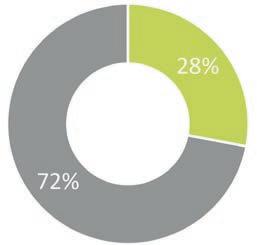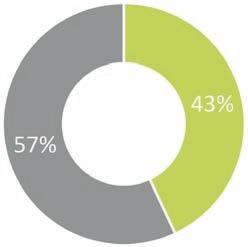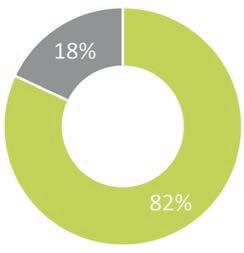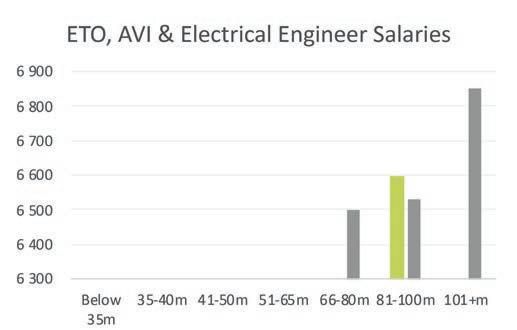
9 minute read
WORTH YOUR SALT
Launched in 2016 the YPI Crew Salaries website provides the most detailed salary information within the industry across all the positions on board the yacht
Salary is generally one of the top motivators when choosing a job onboard a yacht, yet it is usually one of the best kept secrets within the industry. When negotiating the final salary, it’s important that both the employer and employee have an idea of what the standard is for that particular position. This will help keep the transparency and build trust.
Advertisement
THE IMPORTANCE OF SALARY REPORTS Informed employers recognise that in order to attract the top level of talent and experience for a particular role, one of the strongest influences they have is the salary they can offer. To stay competitive within the industry you have to offer competitive salaries that reflect the current marketplace. And in order to do this, you have to know what the current market rate is. Equally, employees can use a salary report such as this as an orientation point to get an idea if a job offer is reflective of the industry and the role they serve.
THE DATA AND HOW YPI COLLECT IT In 2016, YPI CREW launched a peer-topeer salary comparison website for the yachting industry. Here, anyone working in the industry is welcome to anonymously enter their salary along with their rank. The site has so far attracted over 5,655 salary entries since its launch and best of all, the salary data is free for anyone to access.
The figures shown here are median values of the real salaries entered by yachting crew. They can be used as orientational figures but the real salary offered during the recruitment process will vary depending on the candidate’s experience, training, certificates and additional skills, but these figures are a solid sounding board. All salaries are expressed in euros. Please note that the blanks in the graphs are due to either lack of entries for that particular category or the non-existence of a role in a specific segment. For example, there are generally no third officers on yachts less than 50 metres.
Data presented here is collected from anonymous yacht crew members and it should not be seen as a definite portrayal of the current market but merely an informal indication.
As salary data is entered by members of the community the site works on an honesty system. There is really no incentive for contributors to mislead people about what they earn.
To visit the site to contribute your salary or conduct a free search of the salary database, visit www.yachtingsalaries.com
CAPTAINS 2020
347 captains have contributed with their salaries and of those, 287 (82%) are working on motor yachts and 60 (18%) on sailing yachts. Overall, only 33% of captains who contributed are on rotation, which usually, if and when available, starts on yachts over 50m. Experienced recruiters are invaluable at this level as they can definitely add value in the salary negotiation stage; it is their role to act as a middle person to ensure that, when a job offer is made, it is to all parties’ satisfaction and is therefore accepted. They know how best to champion their skills, experience and to craft and finesse a deal.
Captains | Permanent vs. Rotation
Captain Salaries | Motor Yacht Captain Salaries | Sailing Yacht


279 technical crew have contributed; 162 chief engineers, 60 second engineers, 16 third engineers and 25 ETO/AVIT. Overall, many more engineers reported being on rotation than captains. We see that 72% of Chief Engineers, 57% of Second Engineers and 56% of Third Engineers are rotational, along with 88% of ETO/AVIT Engineers. For chief engineers we note that beyond the 66 – 80m segment, there is no data for permanent salaries. This reflects the engineering recruitment market where in fact, from +65m upwards, the market is rotation only, apart from a few exceptions. The same goes for Second Engineers and ETOs where permanent contracts on +65m yachts are for build contracts only. It is our experience that the market is rotation-only for Engineers on operational yachts over 65m.






214 Deck Crew have contributed with their salaries breaking down to 116 chief officers 16 second officers, 12 third officers and 64 deckhands. From the data we see that fewer chief officers (43%) reported having a rotational position compared to second engineers (57%). However, they reportedly benefit more from rotation than captains who are at 33%.




Third Officer | Bosun Third Officer / Bosun | Permanent vs. Rotation


34 Pursers, 61 Chief Stews and 22 Second Stews contributed with their salaries. Pursers, after Engineers are the category who most have access to rotation. 59 % of Pursers reported having rotation whilst only 18% of Chief Stews said they benefit from that perk. Our experience is that in the past year, perhaps due to Covid-19, salaries offered to Stews were somewhat lower that the year before. But with the season back in full swing we expect to see this change.
Purser Salaries Pursers | Permanent vs. Rotation


Chief Stew Salaries
Stew Salaries Chief Stews| Permanent vs. Rotation


Second Stew Salaries


65 chefs contributed with their salaries of which 50 were Head Chefs and 15 Sous Chefs. It is our experience that at the point of recruitment on yachts +50m, most Chefs jobs offer some sort of rotation so it is surprising that only 26% of chefs who contributed are on rotation. This could be due the percentage of chefs on under 50m contributing.
Chef Salaries
ETO, AVI & ELECTRICAL ENGINEERS 2020

ETO, AVI & Electrical Engineer Salaries
DECKHANDS 2020

214 Deck Crew have contributed with their salaries breaking down to 116 chief officers 16 second officers, 12 third officers and 64 deckhands. From the data we see that fewer chief
Deckhand Salaries Chefs | Permanent vs. Rotation



officers (43%) reported having a rotational position, compared to second engineers (57%). However, they reportedly benefit more from rotation than captains who are at 33%.
Deckhands | Permanent vs. Rotation

BVI BENEFITS
John Samuel looks at increasing the Virgin Islands Shipping Registry’s efficiency and creating added benefits for commercial and private yachts
Located to the east of Puerto Rico and the west of St. Maarten, nestled between beautiful tropical islands and surrounded by the clear blue waters of the Caribbean Sea, the British Virgin Islands boasts a sailor’s paradise. With options of 60 islands and cays and various anchorages throughout, the waters of the BVI are the perfect choice for maritime activity for boaters worldwide.
This tiny British Caribbean Territory is much more than a vacation destination; it is the ultimate destination for companies owning international and BVI yachts, owners and guests onboard. The BVI is a maritime nation authorised via international maritime conventions extended by the United Kingdom, creating a superior operational and management foundation for maritime operations.

As the maritime administration arm of the BVI, the Virgin Islands Shipping Registry (VISR) executes and enforces maritime standards and legislation relative to the safety and navigation for boats within the Territory and vessels registered under the BVI flag.
The VISR comprises of a team of highly qualified staff which includes maritime registrars, surveyors, and inspectors; a full complement of technical staff enabling full support and certification capabilities across all vessel types, maritime conventions and vessel codes.
There is much to look forward to for yachters and service providers sailing to or interested in registering their vessel in the British Virgin Islands. Benefits to be derived includes: • Three options for port registration which includes Road Harbour, Gorda Sound or White Bay • Fully functioning Red Ensign register and flag, which guarantees the highest quality and standards and allows for hassle free transit into and out of foreign ports • Upgraded consumer portals and electronic platforms that facilitate greater efficiency for certification and registering vessels
The new Director of the Virgin Islands Shipping Registry, Mr. John Samuel speaks to a new direction for the organisation, “My goal as we move into the upcoming cruising season, with the projected easement of COVID-19, is to reinvigorate the Shipping Registry with a new purpose of being more efficient and effective, with a core focus of creating added value and benefits for our clients. Our customers are important to us and we want to ensure that when they register under the BVI flag they receive special benefits that will set them apart from vessels registered elsewhere. In so doing, our aim is to leverage the destinations appeal with the addition of a cadre of processing and economic advantages that will be launched in fall 2021. Additionally, we are assiduously working on policies that will benefit yachts owned by a BVI Company, registered in the BVI, and based in the BVI. These policies will allow for unrestricted trading between BVI islands, unrestricted charters per year, duty exemptions, easier customs and immigration clearances and the application of lower fees in a simplistic fee structure.”
With a new direction and added benefits for BVI flagged vessels, the Virgin Islands Shipping Registry is full steam ahead in implementing major enhancements to its maritime product and services. Why not choose the BVI for all your maritime needs.
RED ENSIGN The Red Ensign flown by BVI ships provides a highly valued guarantee of the integrity of the registration process and the ability to record and legally prove a mortgage under English Law. VISR also benefits from all technical research and development work created and carried out by the Red Ensign group of flags. This ensures that the organisation remains on the cutting edge of industry developments and maintains a quality maritime administration, while being free to establish a specialised customer service approach and create an economic regime consonant with the polices of the BVI.
For more details email: bvishipping@bvimaritime.vg or visit www.bvimaritime.vg










